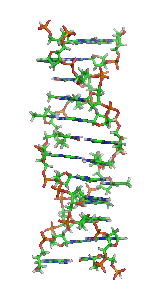DNA : For NIPER JEE
Introduction
DNA exists in many possible conformations that include A-DNA, B-DNA, and Z-DNA forms.
Only B-DNA and Z-DNA have been directly observed in functional organisms.
The conformation that DNA adopts depends on the hydration level, DNA sequence, the amount and direction of supercoiling, chemical modifications of the bases, the type and concentration of metal ions, as well as the presence of polyamines in solution.
The first published reports of A-DNA X-ray diffraction patterns— and also B-DNA used analyses based on Patterson transforms that provided only a limited amount of structural information for oriented fibers of DNA.
An alternate analysis was then proposed by Wilkins et al., in 1953, for the in vivo B-DNA X-ray diffraction/scattering patterns of highly hydrated DNA fibers in terms of squares of Bessel functions.
In the same journal, James D. Watson and Francis Crick presented their molecular modeling analysis of the DNA X-ray diffraction patterns to suggest that the structure was a double-helix.
Although the `B-DNA form' is most common under the conditions found in cells,it is not a well-defined conformation but a family of related DNA conformations that occur at the high hydration levels present in living cells.
Their corresponding X-ray diffraction and scattering patterns are characteristic of molecular paracrystals with a significant degree of disorder.
Compared to B-DNA, the A-DNA form is a wider right-handed spiral, with a shallow, wide minor groove and a narrower, deeper major groove.
The A form occurs under non-physiological conditions in partially dehydrated samples of DNA, while in the cell it may be produced in hybrid pairings of DNA and RNA strands, as well as in enzyme-DNA complexes.
Segments of DNA where the bases have been chemically modified by methylation may undergo a larger change in conformation and adopt the Z form. Here, the strands turn about the helical axis in a left-handed spiral, the opposite of the more common B form.These unusual structures can be recognized by specific Z-DNA binding proteins and may be involved in the regulation of transcription.
In 1953, James D. Watson and Francis Crick suggested what is now accepted as the first correct double-helix model of DNA structure in the journal Nature.(Nature is very famous international journal having high Impact factor.)
Their double-helix, molecular model of DNA was then based on a single X-ray diffraction image (labeled as "Photo 51")
Chargaff's rules played a very important role in establishing double-helix configurations for B-DNA as well as A-DNA.Chargaff's rules state that DNA from any cell of all organisms should have a 1:1 ratio of pyrimidine and purine bases and, more specifically, that the amount of guanine is equal to cytosine and the amount of adenine is equal to thymine. This pattern is found in both strands of the DNA. They were discovered by Austrian chemist Erwin Chargaff.
Chargaff Parity Rule 1:
The first rule holds that a double-stranded DNA molecule globally has percentage base pair equality: %A = %T and %G = %C.The rigorous validation of the rule constitutes the basis of Watson-Crick pairs in the DNA double helix.
Chargaff Parity Rule 2:
The second rule holds that both %A ~ %T and %G ~ %C are valid for each of the two DNA strands.This describes only a global feature of the base composition in a single DNA strand.
A DNA sequence is called "sense" if its sequence is the same as that of a messenger RNA copy that is translated into protein.
The sequence on the opposite strand is called the "antisense" sequence.
Plasmid is a DNA molecule that is separate from, and can replicate independently of, the chromosomal DNA.They are double-stranded and, in many cases, circular. Plasmids usually occur naturally in bacteria, but are sometimes found in eukaryotic organisms (e.g., the 2-micrometre-ring plasmid in Saccharomyces cerevisiae).
Subscribe to:
Post Comments (Atom)


No comments:
Post a Comment